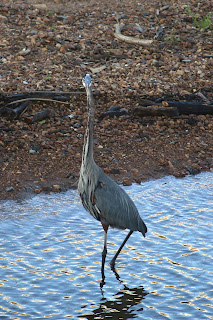Great Blue Heron on the Cumberland River
By
Kate Crowley
We are currently
cruising up the Cumberland River, headed to Nashville. This is all new territory for us and as
naturalists we are excited to see new landscapes and rivers. We call the Cumberland a river, but in this
stretch, up from Paducah, it is part of a reservoir system created by the TVA
in the 1930s. Because it is such, there
is far less current than we find on the Mississippi River and it is a popular
spot for fishing; For both people and
birds.
While we were docked in
Paducah, on the Ohio, we looked out the window one morning and found ourselves
being observed by a Great Blue Heron just a few yards away from us. It was stalking, as these birds often do,
along the very edge of the shore, lifting one impossibly long leg after the
other in slow motion. We could see how
the toes flopped down when the foot was raised, and opened as they went back
into the water. It tilted its head so its eye could see the water, then lifted
it up and looked directly at us. We
stared back.
It is not often that
you can get close to a Great Blue Heron. They are wary birds and even when you
are in a canoe, drifting quietly along, as soon as they see you, they spread
their nearly six foot wings and lift up, often issuing a hoarse croak as a
parting shot. This bird however was not
frightened by our presence and continued to slowly move onto a log, one foot in
front of the other, like a graceful tightrope walker. It stuck its bill into the
water a couple times, but not in the quick stabbing motion they use when a fish
or frog is caught. These were more like
dainty dips.
It turned again and
faced us and we could see the dark russet feathers that cover its upper legs,
like a pair of pantaloons. This color is hard to see on the bird normally,
because the grey belly feathers cover most of this area. We also got to see the long, gray, draping
plumes that cover the chest. These are specialized feathers that grow
continuously and therefore begin to fray over time. They are also known as ‘powder down”. Using a fringed claw on their middle toes,
the herons can comb this downy material over their over feathers to help remove
dirt, oils and other materials they pick up while wading.
Eventually it took off,
flying further down the shore, but seeing that heron was a treat, especially
because we see so little of their kind along the lower Mississippi River. These birds need shallow, slow moving or
stagnant water to find their food. The
Cumberland that we are on now is the exact opposite of the Mississippi in term
of birdlife. Ever since we have been on
it, we have seen Great Blue Herons, Great Egrets, White Pelicans, Double
crested Cormorants, Bald Eagles and lots of gulls. The abundance is impressive
and a joy to see for two old naturalists.
 There are lots of
sandbars, islands and dead trees in this river, which is understandable
considering it is a flooded valley. The
boat must stay well within the marked channel or it would quickly run aground. There is barge traffic on this river too, but
far less than you see on the Ohio and Mississippi.
There are lots of
sandbars, islands and dead trees in this river, which is understandable
considering it is a flooded valley. The
boat must stay well within the marked channel or it would quickly run aground. There is barge traffic on this river too, but
far less than you see on the Ohio and Mississippi.  We won’t see these long
necked, pterodactyl-looking wading birds in northern Minnesota for another
seven months. But for now they seem to
have found a good place to rest as the season changes.
We won’t see these long
necked, pterodactyl-looking wading birds in northern Minnesota for another
seven months. But for now they seem to
have found a good place to rest as the season changes. 





Comments
Post a Comment